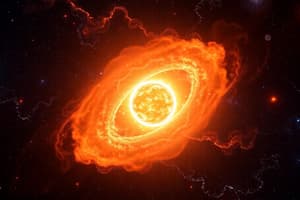Podcast
Questions and Answers
What is the main premise of the cosmic theory regarding the origin of the universe?
What is the main premise of the cosmic theory regarding the origin of the universe?
The cosmic theory proposes that the universe began with a singular explosion followed by a burst of inflationary expansion.
What problems in cosmology does Alan Guth's inflation model aim to address?
What problems in cosmology does Alan Guth's inflation model aim to address?
Guth's inflation model addresses the horizon problem and the flatness problem.
Explain the central idea of the Steady-State Theory.
Explain the central idea of the Steady-State Theory.
The Steady-State Theory posits that the universe has no beginning or end and maintains a constant density through the continuous creation of matter.
Who originally formalized the Big Bang Theory and what observation led to its development?
Who originally formalized the Big Bang Theory and what observation led to its development?
How did Newton's Principia influence the understanding of the solar system's origin?
How did Newton's Principia influence the understanding of the solar system's origin?
What are the essential components of the heliocentric model of the solar system?
What are the essential components of the heliocentric model of the solar system?
What key aspect distinguishes the Big Bang Theory from the Steady-State Theory?
What key aspect distinguishes the Big Bang Theory from the Steady-State Theory?
What role do quantum fluctuations play in the cosmic theory of the universe's origin?
What role do quantum fluctuations play in the cosmic theory of the universe's origin?
What does the Accretion Theory propose about the formation of the solar system?
What does the Accretion Theory propose about the formation of the solar system?
How does the Protoplanet Theory differ from the Accretion Theory?
How does the Protoplanet Theory differ from the Accretion Theory?
What is the main premise of the Capture Theory in the context of solar system formation?
What is the main premise of the Capture Theory in the context of solar system formation?
Describe the basic idea behind the Modern Laplacian Theory.
Describe the basic idea behind the Modern Laplacian Theory.
What does the Nebular Theory state about the formation of the solar system?
What does the Nebular Theory state about the formation of the solar system?
Explain how gravity plays a role in the formation of the solar system according to the provided theories.
Explain how gravity plays a role in the formation of the solar system according to the provided theories.
What evidence challenges the Capture Theory regarding the ages of the solar system's components?
What evidence challenges the Capture Theory regarding the ages of the solar system's components?
In what way does the Protoplanet Theory account for the rotation rates of planets?
In what way does the Protoplanet Theory account for the rotation rates of planets?
Flashcards are hidden until you start studying
Study Notes
Cosmology
- Cosmology studies the origin and evolution of the universe, covering its history from the Big Bang to its potential future.
- The universe's inception is explained by cosmic theory involving an initial explosion followed by inflationary expansion.
- Alan Guth proposed the inflation model in 1980 addressing the horizon and flatness problems and detailing how quantum fluctuations amplified to form galaxies.
Big Bang Theory
- Developed by Georges Lemaître, this theory centers on the observation that galaxies are receding from Earth, implying a massive explosion occurred around 10 to 20 billion years ago.
- Suggests all known matter and energy originated from a singular point of unknown energy.
Steady-State Theory
- Proposed by Hermann Bondi, Thomas Gold, and Sir Fred Hoyle, positing that the universe has no beginning or end.
- States the universe expands while maintaining constant appearance through continuous matter creation.
Theories of Origins of the Solar System
- The heliocentric model, established before the late 17th century, became scientifically analyzed after Newton's "Principia" in 1687.
Accretion Theory
- Asserts the solar system formed from a rotating nebula — a dense cloud of gas and dust colliding and sticking together to form larger masses.
Protoplanet Theory
- Proposes that a dense interstellar cloud produced clusters of stars, where smaller blobs of matter coalesced into the Sun and planets through random spins.
Capture Theory
- Developed by Michael Woolfson, this theory suggests the Sun formed from tidal interactions with a low-density protostar, although it results in discrepancies regarding the ages of the Sun and planets.
Modern Laplacian Theory
- Proposed by Pierre-Simon Laplace in 1796, suggesting the Sun and planets formed from a rotating nebula that cooled, fragmenting into rings, leading to the formation of planets.
Nebular Theory
- Describes solar system formation from a nebula composed of gas and dust approximately 4.5 billion years ago.
- As gravity condensed regions of this gas cloud, denser areas formed clumps of matter, ultimately creating the Sun and planets.
Studying That Suits You
Use AI to generate personalized quizzes and flashcards to suit your learning preferences.




